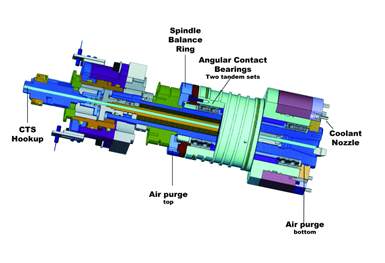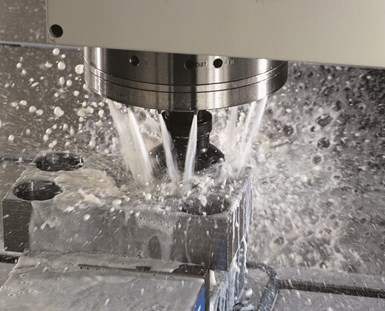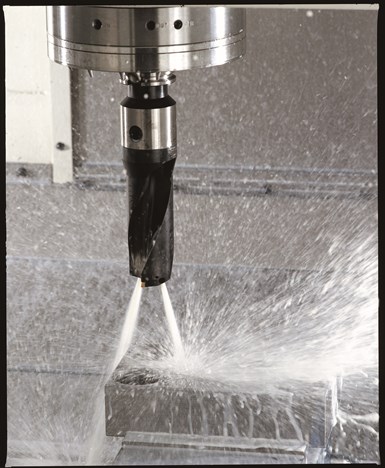
The design of the spindle and the quality of the parts contained within the spindle are important factors that contribute to the spindle’s longevity. The spindle designed with features that keep chips and coolant out of the spindle’s bearing system, such as an air purge system and wipers that use positive lubrication pressure to protect the spindle from contaminants. Photo Credit, all images: Hurco
Everyone knows the importance of the basic spindle specs when you purchase a CNC machining center: max spindle speed, peak spindle motor horsepower and max spindle motor torque.
The power you need depends upon the stock you’re cutting. Obviously torque, speed and horsepower are important specs to evaluate when you’re getting ready to purchase a vertical machining center (VMC), but there are a few other considerations that will be critical to the overall performance of your spindle and your overall satisfaction with the investment you make when purchasing a CNC VMC. Because many integral parts of the spindle are buried within it, finding out what you need to know requires preparation, research and asking the right questions.
Featured Content
What’s Inside and Why It Matters
At first blush, it might appear that the actual spindle doesn’t do much on a VMC — the tool cuts the metal, the table moves, the motion control system controls the precision and movement and the software does the rest. The spindle is nothing more than a motor that lets a tool be attached to it and takes commands from a servo.
The above depiction may be true — the spindle may not be overly complex or smart or beautiful, but it sure does work hard and endures a lot of abuse. The amount of force and wear and tear it must endure means the design of the spindle and the quality of the parts buried within the spindle are vital to your spindle’s performance and its lifespan. The spindle is truly the heart of the machining center.
Quality components not only determine longevity of the spindle, they determine how the spindle handles speed, torque and vibration. When you start to research spindle technology, you find the bearing system is often at the center of the discussion. It can get mind boggling, especially with the acronyms flowing freely — dN value benchmarks and formulas, O or DB mounting versus DF or X configuration, ABEC standards and so on. An overview of key considerations when researching a CNC machining center’s bearing system covers the highlights — material, type, arrangement and lubrication.
Bearing System of the Spindle
In a bearing system, the balls roll between the inner and outer steel raceways. The material used for the ball bearings affects temperature, vibration levels and the life of the spindle. Hybrid ceramic bearings offer distinct advantages over typical steel ball bearings.
Advantages of Hybrid Ceramic Bearings
Less mass
Ceramic ball bearings have 60% less mass than steel balls. This is significant because as a ball bearing is operating, particularly at high rotational speeds, centrifugal forces push the balls to the outer race and even begin to deform the shape of the ball. When the bearing starts to deform, it starts wearing faster and leads to deterioration. Ceramic balls with less mass will not be affected as much at the same speed. In fact, the use of ceramic balls enables up to 30% higher speed for a given ball bearing size without sacrificing bearing life, according to information from a manufacturer of high-speed milling spindles.1
Elimination of cold welding
Ceramic balls do not react with the steel raceways, eliminating a condition called cold welding — a major cause of bearing failure. Cold welding occurs when the microscopic cold welding of ball material to the raceway causes surface wear. The cold welds actually break as the bearings rotate and that creates surface roughness that leads to heat generation and bearing failure.
Operation at lower temperatures
Due to the nearly perfect roundness of the ceramic balls, hybrid ceramic bearings operate at much lower temperatures than steel ball bearings, which results in longer life for the bearing lubricant.
Lower vibration levels
Tests show that spindles utilizing hybrid ceramic bearings exhibit higher rigidity and have higher natural frequencies, making them less sensitive to vibration, which results in longer life for the bearing lubricant.1
Types of Bearings
There also are different types of bearings, with angular contact ball bearings being the type most commonly used in high-speed spindle design. These bearings provide precision, load carrying capacity and the speed needed for cutting metal. The precision balls are fitted into a precision steel race and provide both axial and radial load carrying capacity.
The other type of bearings sometimes used in spindles includes taper roller or cylindrical roller bearings. The roller (or cylindrical) bearings offer higher load carrying capacity and greater stiffness than ball bearings, and are used in spindles with specific rpm requirements and applications. Oftentimes, the spindle manufacturer will use both types in different parts of the spindle — dependent upon the type of load the bearing must counteract.
Lubrication
Proper lubrication of bearings is essential. There are several systems that machine tool manufacturers use to keep the bearings properly lubricated — such as oil-mist, oil-air, oil-jet and pulsed oil-air.
Such systems are sometimes necessary if bearing spindle speeds are in excess of 18,000, but they add maintenance cost and increase replacement cost of the spindle. Additionally, these lubrication systems must be monitored to make sure the ratio and the amount of oil and air and/or mist are correct.
Permanently lubricated bearings are the best option for keeping maintenance costs down and replacement costs lower. With permanently lubricated bearings, you don’t have to hassle with lubrication — it’s handled during the assembly of the spindle. The bearings can also be pre-packed with grease (permanent lubrication) by the bearing suppliers.
Types of Spindles
Spindle technology offers various ways to drive the spindle — belt, gear, inline and built-in motor. With a belt driven spindle, make sure the belt is easy to maintain and easily accessible to minimize maintenance costs. Additionally, the type of belt will affect the noise level of the machine. A belt with a herringbone design is quieter than other belt designs because of the way it disperses trapped air to reduce the noise.
Gear driven spindles add to the cost of the machine and can be noisier and require more maintenance than their competitor — the belt driven spindle. There was a time when a gear driven spindle may have been preferred over a belt driven spindle, but the advances in materials and belt design have proven it to be a low maintenance alternative.
The inline spindle (sometimes called a direct drive spindle) is designed so the spindle is coupled directly to the motor. Inline spindles provide excellent surface finish and smoother, quieter operation.
Another type of spindle is the built-in motorized spindle that literally has the motor built into the spindle. These spindles are generally used when higher spindle speeds (in excess of 16,000) are required. These spindles are more costly compared to the belt spindles.
No matter the type of spindle, the motor that drives the spindle is obviously important. Motors with two sets of windings — called dual wound spindle motors — provide more cutting torque and material removal. Single wound motors are used where lower torque is sufficient and higher base speeds are not an issue.

Some spindles are designed with a coolant ring that has adjustable nozzles. This picture shows a coolant ring with eight adjustable nozzles to blast away chips and keep the temperature of the tool and workpiece cool.
Enemies of the Spindle
The two major enemies of the spindle are heat and contaminants (namely, chips and coolant invading the bearing system). Find out what design features are included (or available as options) that protect the spindle. Historically, the most common cause of spindle failure has been bearing failure due to contamination from coolant ingress, condensation, contamination or chip damage. You want the spindle temperature to stay cool, and you want to make sure contaminants stay out.
In most cases, contaminants enter the spindle because the spindle seal failed. Find out what design measures the machine tool manufacturer has taken to keep the seal tight. An air purge system uses a labyrinth seal and purges the seal with positive air pressure to keep contaminants out. A dual air purge system, a system with two ports (usually upper and lower) is one design feature that works well to keep contaminants out of the way.
Temperature is the other factor that leads to spindle problems. Because heat causes steel to expand, manufacturers should explain what measures they have taken to protect the spindle from head growth — which leads to mostly Y and Z axis changes.
Heat exchangers or chillers (most common) are used to keep the spindle cool and control spindle growth as well as head growth. This type of system adds life to the spindle and reduces head growth, and is typically used when you’re running long cycles or high duty cycles. The selection of the chiller is dependent upon the application. For extended high-speed applications, you may want to investigate a thermal stabilization system. This system uses a thermostat with an oil chiller to automatically cool the spindle as needed.
Another contributing factor to spindle performance is the tooling used. Using unbalanced tools, worn tools and/or tools that are too long can affect the longevity of your spindle.

Coolant Through the Spindle (CTS) is important to protective expensive and custom tools. When a spindle is designed with CTS in mind, it’s much easier to add this option.
Tooling Considerations
Like the spindle, temperature can have a negative impact on tooling. Find out if the spindle comes with a coolant ring or uses flexible coolant nozzles. With a coolant ring, you want to find out how many nozzles there are and whether they are adjustable. Obviously, the more nozzles the better and having the ability to adjust the direction of the nozzles is an advantage to cover a large range of tool lengths without frequent adjustments.
Coolant Through the Spindle (CTS) is generally recommended when machining at 12,000 rpm or more, and you have custom tools or expensive tools that you want to ensure are protected. CTS also is recommended at lower rpm for certain applications and duty cycles. Prices vary for this feature depending upon the pressure of the CTS and how the spindle was designed.
Replacement Costs
Just like tires on a car, you will eventually need to replace the spindle on your VMC. In your zeal to make a purchasing decision for a brand new machining center, make sure you look ahead to the day when the spindle will need to be replaced. You need to know how much it will cost, availability of your type of spindle and downtime to install.
Summary
The spindle is the workhorse of your machining center. Make sure the manufacturer of your machining center has taken spindle design seriously and has invested in quality components that will help increase the longevity of your machining center’s spindle.
Footnote
1The information on the ceramic hybrid bearings referenced is from William Popoli, President, IBAG North America.
RELATED CONTENT
-
Speed, Productivity Gains and High Uptime Ease Decision for Second Five-Axis Machine
Byrne Tool + Design reduced setups and gained speed and productivity thanks to fast, accurate and compact five-axis CNC machining centers.
-
VIDEO: Simplify Mold Management of Your Tooling Fleet
In this digital demo, Progressive Components explains its basic asset management and mold monitoring system, ProFile, where it is possible to monitor all your assets in one place.
-
From Machining Centers to Cutting Tools: Here are the Top Ten Case Studies from 2022
MMT publishes monthly case studies that present a shop’s problem, solution and results in thorough detail. Take a look at the top ten most popular case studies published in 2022 based on Google Analytics.










.jpg;maxWidth=970;quality=90)




